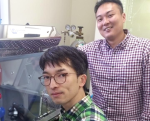Tokyo Metropolitan University’s Researchers Discover a Novel Layered Superconductor Based on Tin and Arsenic

Researchers Discover a Novel Layered Superconductor Based on Tin and Arsenic
Date: Nov 8, 2017
Source: Tokyo Metropolitan University
The layered superconducting material is characterized by a crystal structure in which a SnAs layer (wherein Sn and As are two-dimensionally bonded to develop superconductivity) and a Na layer (the spacer layer) are alternately laminated. Considering that such a layered structure is similar to that of a cuprate- or iron-based high-temperature (high-Tc) superconductor, it is possible that in SnAs-based layered materials, superconductivity is developed as a result of the unconventional pairing mechanism.
The research group of Yoshikazu MIZUGUCHI (Associate Professor) and Yosuke GOTO (Project Researcher) specializes in the discovery of two-dimensional layered structures–various materials can be designed by laminating different kinds of layers. As an example, in 2012, this research group also reported the discovery of novel layered superconducting material systems, Bi4O4S3 and LaO1-xFxBiS2, based on bismuth (Bi) and sulfur (S). To add, as the two-dimensional crystal structure gives rise to a low-dimensional electronic state, researchers are actively studying unique quantum phenomena such as high-temperature superconductivity.

The scientists of Tokyo Metropolitan University are always working on the creation and theoretical clarification of new superconducting materials. Yosuke Goto, Project Researcher (left), and Associate Professor Yoshikazu Mizuguchi discovered that SnAs-based layered compounds develop superconductivity. Credit: Yoshikazu Mizuguchi
Regarding NaSn2As2, Mizuguchi asserts that although the transition temperature of 1.3 K (-271.85°C) is not exactly high, it is anticipated that new materials will be developed based on the SnAs conductive layer, thereby clarifying the mechanisms underlying the increase of the transition temperature as well as those responsible for high-transition-temperature superconductivity.
At Tokyo Metropolitan University, the Research Center for Superconductivity Science and Engineering represented by Professor Takashi HOTTA was established in 2016; Yoshikazu MIZUGUCHI is a faculty member in the Research Center. One of the major objectives of this Research Center is to become a hub of superconductivity research in Japan; it aims to achieve this by promoting the discovery of new quantum critical phenomena, particularly superconductivity, by preparing pure single crystals, measuring their physical properties using state-of-the-art experimental methods, and promoting theoretical researches on exotic superconductivity.
This study was supported by Grants-in-Aid for Scientific Research of the Japan Society for the Promotion of Science, and by the Japan Science and Technology Agency. The manuscript reporting this finding has been published online in the Physical Society of Japan’s Journal of the Physical Society of Japan.









